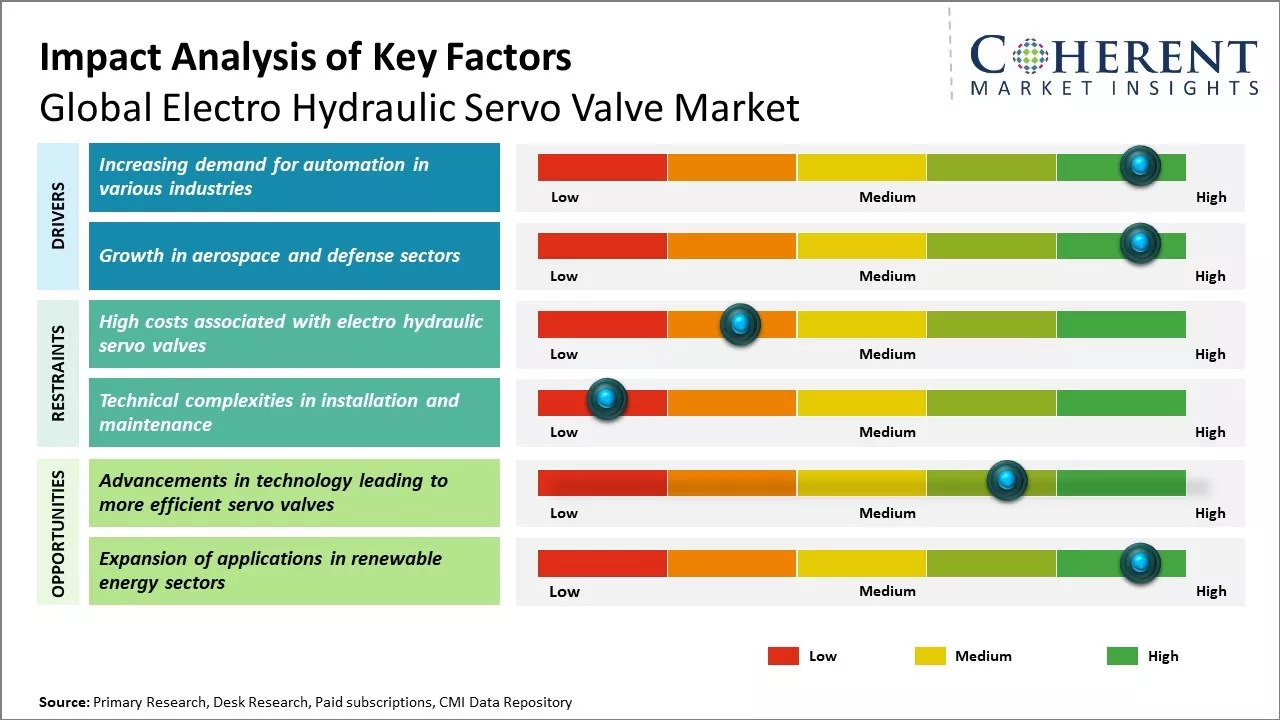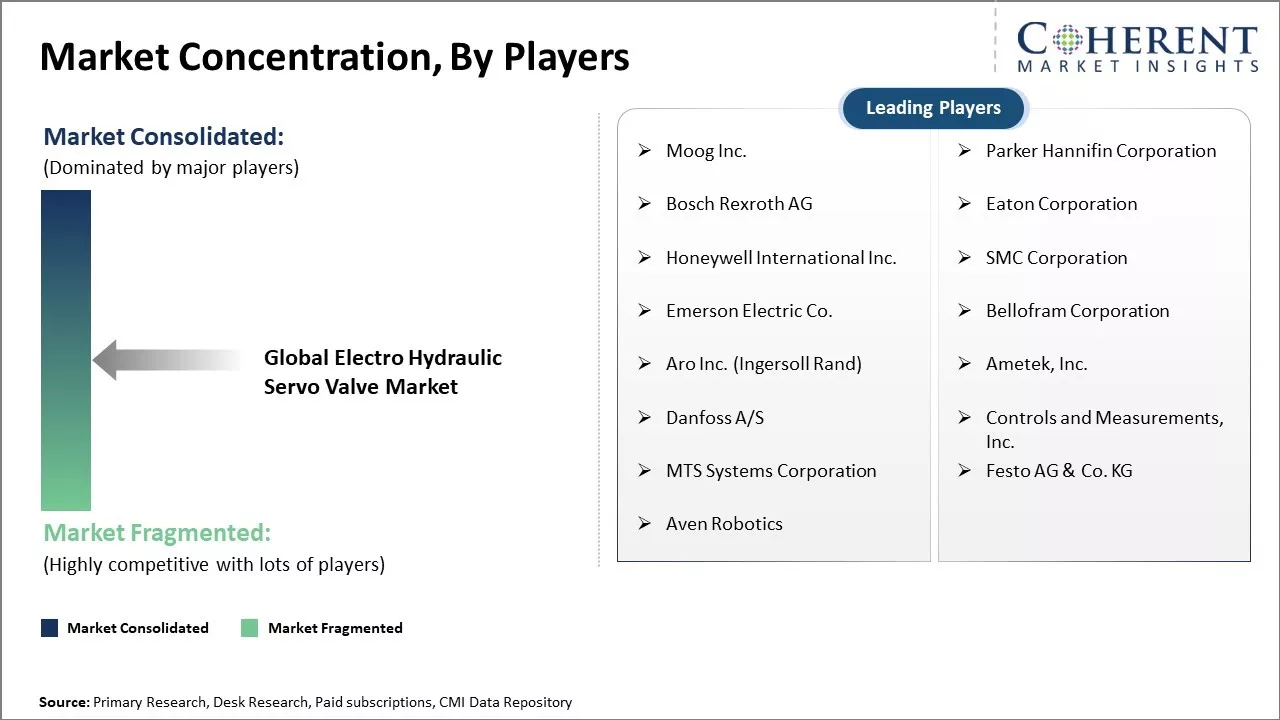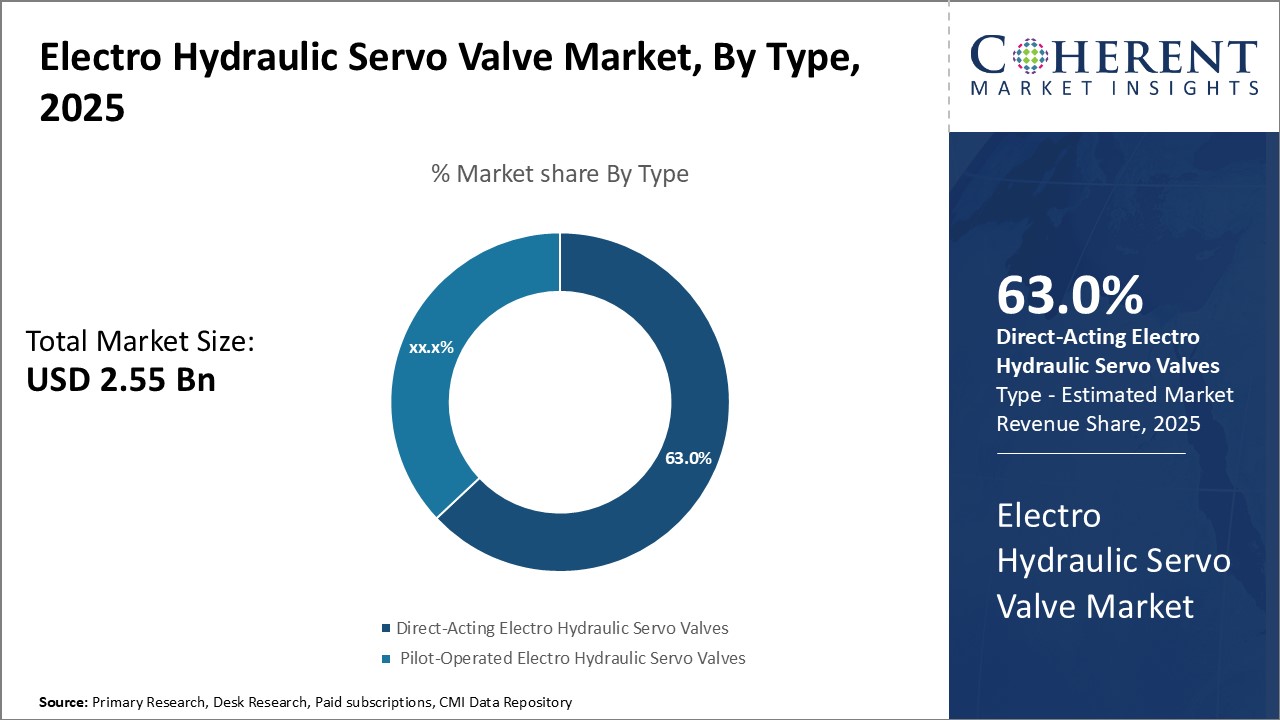Global electro hydraulic servo valve market is estimated to be valued at US$ 2.55 Bn in 2025 and is expected to reach US$ 3.82 Bn by 2032, exhibiting a compound annual growth rate (CAGR) of 5.9% from 2025 to 2032.

Discover market dynamics shaping the industry: Download Free Sample
Electro hydraulic servo valves are extensively used across industrial machinery and equipment to provide effective motion control. Many industries such as Moog Inc., Parker Hannifin Corporation, Bosch Rexroth AG, Eaton Corporation, Honeywell International Inc., SMC Corporation, Emerson Electric Co., etc. are increasingly adopting motion control systems to achieve precision and improve productivity. Global electro hydraulic servo valve market growth is driven by implementation of industrial automation and focus on manufacturing process efficiency. Rising adoption of robotics across automotive, semiconductor, electronics and food & beverages industries can drive the electro hydraulic servo valve market growth.
Market Driver - Increasing Demand for Automation in Various Industries
The manufacturing industry across the world has been increasingly adopting various forms of automation technologies in their production processes over the past few decades. One of the major driving forces for this shift has been the rising labor costs in many developing and developed nations like China, U.S., Canada, etc. With rising factory wages, companies have been prompted to invest in automation solutions that can perform repetitive and physically intensive tasks more efficiently as compared to human laborers. Electro hydraulic servo valves that provide precise fluid control play a vital role in enabling automation in various machines and industrial equipment. With their high accuracy and responsiveness, these valves allow complex automated systems to function smoothly.
Automotive sector has witnessed rising levels of automation. Major automakers like Moog Inc., Parker Hannifin Corporation, Bosch Rexroth AG, Eaton Corporation, Honeywell International Inc., SMC Corporation, etc. are incorporating more robotic systems and automated machinery into their vehicle assembly lines to boost productivity and quality. Electro hydraulic servo valves manage the hydraulic circuits that power the motions of robots welding parts, applying paint and installing components. Their precise control at micro-levels is essential for the intricate assembly of modern vehicles. Other manufacturing industries such as food processing, electronics, machinery production and plastics have also been automating substantially. Factories now have a much higher usage of robotic arms, conveyor lines, packing machines, and industrial handlers that require electro hydraulic components for motion control applications.
Even sectors such as construction and mining which traditionally relied more on human labor are embracing automation technologies. Robotics and remote-controlled equipment are gaining popularity in areas like earth-moving, tunnel-boring and high-rise construction where worker safety is a major concern. Hydraulic systems equipped with electro hydraulic servo valves enable these heavy machinery to function autonomously with commanding precision. Global push for higher productivity and lower costs especially amid post-pandemic economic recovery pressures can fuel the automation transition across industries. This growing mechanization trend boosts demand for electro hydraulic servo valves that amplify the capabilities of automated plants, tools and equipment.

Get actionable strategies to beat competition: Download Free Sample
Growth in Aerospace and Defense Sectors
The aerospace and defense industries occupy a critical position globally and are characterized by stringent standards of quality, safety and precision. Both sectors have become major end users of electro hydraulic servo valves, owing to their sophisticated requirements. In commercial aerospace, these valves play an important role in flight critical actuation systems controlling wing and tail surfaces, landing gears and other functions. Their capabilities for accurately actuating hydraulic motors and cylinders at airport frequencies and in high vibration conditions makes them well-suited for aviation use. Defense platforms like aircraft, helicopters, ships and tanks depend significantly on electro hydraulic subsystems for functions such as weapons deployment, pilot assist controls and motion operations.
Military spending has been rising across many nations amid geopolitical tensions and threats. Leading countries continue to invest heavily in developing new fighter jets, helicopters, missiles, naval vessels as well as upgrading existing fleets. This has translated into increased orders for aerospace OEMs and their tier 1 suppliers. Commercial aviation industry is recovering strongly post-pandemic with air travel demand rebounding globally. Major aircraft manufacturers like Boeing and Airbus have ramped up production levels on popular narrowbody and widebody models to meet the swelling order backlogs. Both these factors portend robust growth opportunities for hydraulic system component providers including electro servo valves catering to military and commercial aerospace needs.
Key Takeaways from Analyst:
Global electro hydraulic servo valve market growth is driven by rising adoption of automation across industries such as manufacturing, aerospace, and automotive. These valves play a critical role in automation systems by providing precise control of hydraulic actuators and fluids. Their accuracy and response times make them well-suited for applications requiring precision motion control. North America is expected to emerge as the dominating as well as the fastest growing regional market, owing to increasing investments in industrial automation by U.S. and Canada manufacturers.
Availability of cheaper substitutes such as hydraulic cylinders and electric actuators can hamper the market growth. Fluctuating raw material prices may challenge component manufacturers. Moreover, high costs associated with electro hydraulic servo valves hamper their adoption in low-budget applications and developing markets in North America and Asia Pacific. Opportunities lie in increasing utilization of robotics and growing adoption of advanced process control technologies across automotive plants. Developments in nano-electro-mechanical systems also provide scope for product differentiation and innovation.
Market Challenge - High Costs Associated with Electro Hydraulic Servo Valves
Global electro hydraulic servo valve market growth can be hampered due to high costs associated with these valves. Electro hydraulic servo valves are sophisticated technology-based products which have many components like solenoids, sensors, integrated circuits, and others. The manufacturing of these precise components at a mass scale requires heavy investment in R&D and automated manufacturing equipment. Furthermore, the materials used like stainless steel and specialized alloys also increases the production costs. The high costs pose affordability issues for applications which require large volume adoption of these valves like mobile hydraulic equipment and industrial machinery. It also limits the scope of using these valves in developing markets and price sensitive segments. To increase sales volumes, manufacturers need to optimize production processes and develop low-cost alternatives without compromising on precision and performance.
Opportunity- Advancements in Technology Leading to More Efficient Servo Valves
Global electro hydraulic servo valve market can witness growth opportunities from ongoing advancements in the field of mechatronics and integrated circuit technology. Continuous R&D enables improvements in valve designs which enhance efficiency, response time and power density. For example, new manufacturing techniques allow shrinkage of components and miniaturization of solenoids. This leads to more compact valve packages which require less hydraulic power and offer faster switching capabilities. Integration of smarter digital drivers and advanced sensor technology provides functionality upgrades in valves. These evolving product features are well suited for applications like collaborative robots, unmanned aerial vehicles and electric vehicles where efficiency, reliability and small size electro hydraulic components are necessary. The technological upgrades also make valves cost effective to produce. This expanding range of efficient and affordable electro hydraulic options can capture additional market demand in the near future.

Discover high revenue pocket segments and roadmap to it: Download Free Sample
Insights By Type - Precision and reliability drives direct-acting electro hydraulic servo valves segment
In terms of type, direct-acting electro hydraulic servo valves segment is estimated to contribute the highest market share of 63.0% in 2025, owing to their precise, reliable operation suitable for aerospace and industrial machinery applications. Direct-acting valves have a simpler design compared to pilot-operated valves, with the electric signal controlling hydraulic port directly. This translates to faster and more precise control of hydraulic actuator movement. Their reliable and robust operation even in harsh environments also makes them preferable for defense and space applications requiring ultimate precision. As manufacturing complexity increases across industries, there will be huge demand for direct-acting valves that can control machines and robotic arms with minimal error. Their integration into 3D printing machinery, CNC machines and semiconductor manufacturing equipment further drives their market dominance in industrial machinery sector.
Insights By Application - Aerospace & Defense applications enable direct-acting valves market
In terms of application, aerospace & defense segment is estimated to contribute the highest market share of 37.6% in 2025. Within this segment, direct-acting valves are the technology of choice due to their high accuracy and robustness. Being a critical component influencing flight controls and missile guidance, these valves need to operate dependably even in extreme conditions of temperature, pressure and vibration. Aerospace & defense segment fulfill these design requirements through their simple and sturdy mechanism unaffected by external disturbances. Leading aerospace OEMs rely on them for flight control on commercial and military aircraft. These are also used in defense platforms like helicopters, UAVs and aircraft carriers to precisely maneuver various parts. Space-bound valves need to endure vacuum and radiation in addition to vibration and ensure flawless movement of satellite parts; here too direct-acting valves inherit dependability makes them suitable for applications on satellites and space stations.
For instance, in March 2023, Eaton Corporation, a global leader in power management solutions, expanded its manufacturing facility in Europe to increase production of servo valves. This expansion is part of Eaton's strategy to enhance its capabilities in the hydraulics market, particularly in response to the growing demand for advanced hydraulic solutions across various industries. By investing in its European operations, Eaton aims to improve its production efficiency and meet the needs of customers seeking high-performance servo valves for applications in aerospace, automotive, and industrial automation. This move reflects Eaton's commitment to innovation and operational excellence, positioning the company for sustained growth in the competitive hydraulics sector.
Insights By End User - Oil & Gas sector boosts demand through rigorous operating conditions
In terms of end user, oil & gas segment is estimated to contribute the highest market share of 32.1% in 2025. Downhole and offshore oil & gas rig operations involve extreme pressure, vibration and fluid viscosity, demanding rugged and precise actuation of rig components. Here, direct-acting valves excel through their simple and robust mechanism able to withstand the harshest conditions. Both onshore and offshore drilling rigs extensively use direct-acting valves to control sludge pumps, mud pumps, BOP actuators and other downhole tools with unmatched accuracy even in the presence of drilling fluids and cuttings. Subsea production platforms and oil tankers also install them on various machinery subjected to marine environment. As automation increases across exploration, extraction and transportation stages, direct-acting valves provide consistent performance during routine operations as well emergency shut-downs. This makes them a mainstay in capital intensive projects and reliability-critical applications within the oil & gas industry.

Need a Different Region or Segment? Download Free Sample
North America has established itself as the dominant regional market for electro hydraulic servo valve globally with an estimated market share of 40.2% in 2025. The region accounts for over 30.5% of the worldwide demand, owing to robust presence of aerospace and defense industries in the U.S. and Canada. Major military players like Lockheed Martin, Boeing and Northrop Grumman have their manufacturing and R&D hubs in the region and source a large number of these valves for their aircraft, helicopters, ships and other military platforms. Furthermore, automotive sector in the U.S. and Canada adopts hydraulic systems at a rising pace in heavy commercial vehicles, mining and construction equipment which is driving additional valuation to the market.
Strong collaborative ties between valve manufacturers and end users in the development of new and advanced valve design enables faster product innovations and adaptations as per the changing requirements of industries. Leading global players like Moog Inc. and Woodward Inc. have their corporate headquarters and largest manufacturing facilities located in the U.S., ensuring reliability of supply for the domestic demand. Their extensive distribution network across the region further strengthens market presence.
Asia Pacific region has emerged as the fastest growing market for electro hydraulic servo valve globally due to rising manufacturing activities in major economies like China, India and Southeast Asian nations. China, in particular, has witnessed explosive growth in sectors such as automotive, machinery & heavy equipment, aviation and shipbuilding, which consumes a significant number of these valves. Most global players have also set up manufacturing bases in the region to cater to the rising in-country and worldwide requirements from Asia, making it one of the most attractive markets.
Electro Hydraulic Servo Valve Market Report Coverage
| Report Coverage | Details | ||
|---|---|---|---|
| Base Year: | 2024 | Market Size in 2025: | USD 2.55 Bn |
| Historical Data for: | 2020 To 2024 | Forecast Period: | 2025 To 2032 |
| Forecast Period 2025 to 2032 CAGR: | 5.9% | 2032 Value Projection: | USD 3.82 Bn |
| Geographies covered: |
|
||
| Segments covered: |
|
||
| Companies covered: |
Moog Inc., Parker Hannifin Corporation, Bosch Rexroth AG, Eaton Corporation, Honeywell International Inc., SMC Corporation, Emerson Electric Co., Bellofram Corporation, Aro Inc. (Ingersoll Rand), Ametek, Inc., Danfoss A/S, Controls and Measurements, Inc., MTS Systems Corporation, Festo AG & Co. KG, and Aven Robotics |
||
| Growth Drivers: |
|
||
| Restraints & Challenges: |
|
||
Uncover macros and micros vetted on 75+ parameters: Get instant access to report
*Definition: global electro hydraulic servo valve market consists of servo valves that use electrical signals to control proportional hydraulic valves for precise fluid control in industrial machinery and equipment. These valves enable accurate hydraulic positioning and are used in applications like aerospace flight control systems, marine steering systems, construction equipment, industrial robots, and many other production machines where fluid power is required for motion control.
Share
Share
About Author
Ramprasad Bhute is a Senior Research Consultant with over 6 years of experience in market research and business consulting. He manages consulting and market research projects centered on go-to-market strategy, opportunity analysis, competitive landscape, and market size estimation and forecasting. He also advises clients on identifying and targeting absolute opportunities to penetrate untapped markets.
Missing comfort of reading report in your local language? Find your preferred language :
Transform your Strategy with Exclusive Trending Reports :
Frequently Asked Questions
Joining thousands of companies around the world committed to making the Excellent Business Solutions.
View All Our Clients